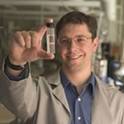
In this paper we report the kinetics and chemistry of cellulose pyrolysis using both a Pyroprobe reactor and a thermogravimetric analyzer mass spectrometer (TGA-MS). We have identified more than 90% of the products from cellulose pyrolysis in a Pyroprobe reactor with a liquid nitrogen trap. The first step in the cellulose pyrolysis is the depolymerization of solid cellulose to form levoglucosan (LGA; 6,8-dioxabicyclo[3.2.1]octane-2,3,4-triol). LGA can undergo dehydration and isomerization reactions to form other anhydrosugars including levoglucosenone (LGO; 6,8-dioxabicyclo[3.2.1]oct-2-en-4-one), 1,4:3,6-dianhydro-β-d-glucopyranose (DGP) and 1,6-anhydro-β-d-glucofuranose (AGF; 2,8-dioxabicyclo[3.2.1]octane-4,6,7-triol). The anhydrosugars can react further to form furans, such as furfural (furan-2-carbaldehyde) and hydroxymethylfurfural (HMF; 5-(hydroxymethyl)furan-2-carbaldehyde) by dehydration reactions or hydroxyacetone (1-hydroxypropan-2-one), glycolaldehyde (2-hydroxyacetaldehyde), and glyceraldehyde (2,3-dihydroxypropanal) by fragmentation and retroaldol condensation reactions. Carbon monoxide and carbon dioxide are formed from decarbonylation and decarboxylation reactions. Char is formed from polymerization of the pyrolysis products. The pyrolytic conversion of cellulose was fitted to two different reaction models. The first model (Model I) combined the first-order kinetic model with a thermal-lag model that assumed the temperature difference between the thermocouple and specimen in TGA to be directly proportional to the heating rate. The second model (Model II) combined the first-order kinetic model with an energy balance that took into account the heat transfer at the sample boundary including the heat flow by endothermic pyrolysis reaction. Both models were able to adequately fit the empirical data. The kinetic parameters obtained from both models were similar. Cellulose pyrolysis had an activation energy of 198 kJ mol−1. Model I is computationally easier, however Model II is physically more realistic. Importantly, our results indicate that the intrinsic kinetics for cellulose pyrolysis are not a function of heating rate. During the pyrolysis of cellulose a thermal temperature gradient between the cellulose and heater can occur due to the endothermic pyrolysis reaction. A faster heating rate can magnify the thermal-lag, which leads kinetic derivations to artificial outcomes.
Available at: http://works.bepress.com/george_huber/25/
